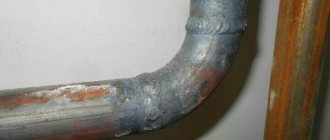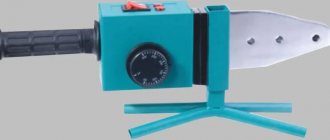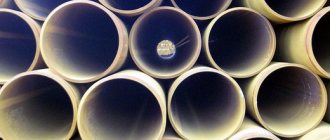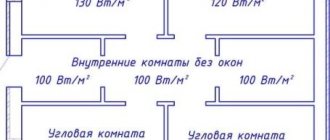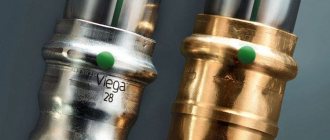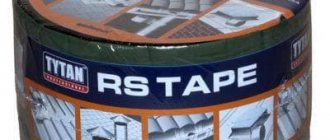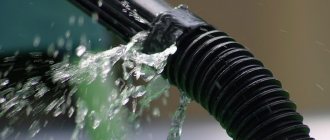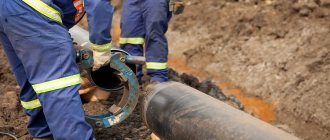Gas pipes are installed regularly. It is prohibited to weld gas pipes yourself. Such work can only be done by a specialist with extensive experience. The most common material for gas pipes is steel. The connection of pipeline components is carried out using plasma, argon arc technology or electric welding. Any types of welding work must be carried out in specially equipped places.
Welding of metal pipes for a gas pipeline is carried out in several ways
Features of gas pipeline welding
The choice of welding technology for gas pipes depends on the material they are made of. The gas industry uses metal and polymer pipes; their welding can be:
- electric arc;
- gas (plasma);
- argon arc;
- diffusion
The welding method depends on specific conditions, for example, pipe wall thickness, type of plastic or steel, outer diameter, etc. The most common method is to weld gas pipes using electric welding. Before starting work, the edges of the pipes are cleaned of corrosion and contamination. If the pipe wall thickness is more than 4 mm, then the edges are beveled, which affects the quality of heating of the metal.
Welding can occur from left to right and vice versa. The first option is used for pipe thicknesses of more than 5 mm. The flame is directed to a section of the pipe that has already been welded. The filler wire moves behind the torch.
Note! This method saves gas consumption and increases productivity.
When the burner moves from right to left, it passes through parts of the products that have not yet been welded. The consumable electrode is located in front of the burner. This method is suitable for connecting thin-walled pipes. Welding seams when working with gas pipes are classified into vertical, horizontal, ceiling and bottom.
Which welding method to use depends on the type of pipe and its location
Electric arc welding
When welding gas pipes using electric welding, work begins with preparing the edges. They are leveled with a grinder at a right angle. Burrs are cleaned with a file. If the walls are thicker than 3 mm, the edges are cut at an angle of up to 60°. Rust and dirt are removed from the joints, then degreasing is carried out.
Before passing the seam, the parts are grabbed in several places with consumable electrodes in several passes:
- thin walls of 3 mm are boiled at a time;
- up to 6 mm – in two layers;
- more than 6 mm thick - three or more.
The rotary joint is passed completely in one step; special rotators are used for this work. If access is difficult, the seam is welded in fragments, filling the entire joint with molten metal. The finishing layer is made continuous, the joints of the welding joints are welded overlapping.

Electric arc welding is carried out in small volumes
Performing argon arc welding
A special feature of TIG (Tungsten Insert Gas) argon arc welding is the use of refractory electrodes. They do not burn out during the formation of the weld. An arc occurs between the metal surface and the electrode after current is applied. Gas (most often argon) enters the working area through a nozzle, which blocks the access of oxygen. The seam is formed in one of the following ways:
- due to the melting of metal edges under the action of an arc;
- through the use of filler wire.
This type of welding of gas pipes allows you to get a good seam on thin metal products. Equipment for this connection technology is represented by rectifiers and argon inverters. A TIG rectifier converts AC to DC. The TIG inverter produces DC power with ideal characteristics. Some models of devices produce alternating current. When working with such equipment, it is possible to control the arc and obtain a high-quality seam.
The main characteristics of machines for argon pipe welding include the type of current and its maximum value. The higher the maximum current value, the thicker the electrodes can be used.
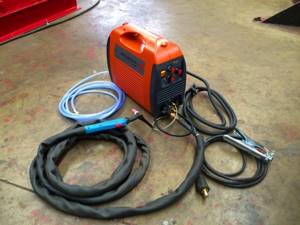
For argon welding you will need a DC machine
Welding of steel pipes is carried out using equipment using direct current (DC). Different argon arc installations have their own maximum welding current values, which range from 150 to 500 A.
Selecting Electrodes
The connection of steel pipeline segments must be carried out using high-quality consumables, otherwise it is unlikely that a good result will be achieved.
For example, when it comes to choosing electrodes, the following models are considered the best:
- ANO-21, ANO-24 and MR-3 . They operate on alternating currents. Work is allowed even with wet coating. The cost of the products is low, which explains their demand in everyday life; they are ideal for connecting structural elements of gates, greenhouses and other light-weight structures that do not experience high loads. Work with pipelines in which the medium is transported under significant pressure is not permitted.
- SSSI . The quality of the cores deserves flattering reviews even from professional welders, but they have a disadvantage - work cannot be carried out at high speed. It is necessary to constantly monitor the stability of the arc; the weld is deposited gradually, so the worker must have some experience in interacting with classic ANO and MR electrodes.
- LB-52U electrodes are excellent for metal pipes . This is a Japanese development. It is the one that is preferred when implementing large projects. They form an even and stable arc, the resulting seam combines strength and aesthetics. The downside is the rather high cost, but they are suitable for both specialists and beginners.
Watch a video on the topic of which electrodes to use for welding pipes:
Basic methods
The connection can be made in one of the following ways:
- Butt joint, when the pipes to be connected are placed opposite each other. The most common option, characterized by relative ease of implementation. However, it is also characterized by certain difficulties. The first point is that it is better to work from below. The second point is that it is necessary to thoroughly weld the metal so that the depth of penetration corresponds to the thickness of the wall.
- Overlapping. This method is focused on connecting elements that initially differ in diameter, or segments, one of which is flared, that is, its diameter is intentionally increased by mechanical action.
- The T-joint is made at a 90-degree angle.
- A corner connection assumes that the angle between the connected segments is less than 90 degrees.

Useful tips
Before electric welding pipes, it is worth remembering a number of tips, following which will simplify the process and also improve the quality of the final result:
- If the connection is made using the butt or tee method, then electrodes whose diameter varies from 2 to 3 millimeters perform best.
- The recommended amperage is from 80 to 100 amperes, with the exception of overlap welding, when it is recommended to increase it to 120 amperes.
- When filling a welding seam, you need to ensure that the rise of the metal above the plane of the element reaches 2-3 millimeters.
- If the cross-section of the pipe is not the usual ovals or circles, but profiles, that is, rectangles and squares, then a point method of connecting it is used.
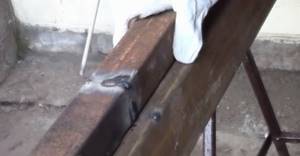
Its essence is that initially you need to weld a small area on one of the sides. Next - a similar section on the opposite side, then - on the remaining two planes. Only after this the pipe is finally welded.
This approach makes it possible to eliminate the possibility of warping of the product when the temperature rises; its geometry remains stable.
Preparatory operations
The final quality of the joint depends not only on the professionalism of the welder and the use of the “correct” electrodes, but also on how well the preliminary preparation is done.

It consists of the following operations:
- Checking the compliance of the geometry of the connected elements with the selected technology. It must be remembered that the wall thickness must be identical, otherwise it will not be possible to fully weld a thick-walled pipe, and in the case of working with a thin-walled product, on the contrary, the risk of burn-through increases.
- The presence of defects on the welded products, be it cracks, creases or deformations, is not allowed. During the process of thermal expansion, they can turn into areas of complete destruction of the structure.
- Geometric deviations of the cut are not allowed. Its angle must be 90 degrees, otherwise the welding seam will not be strong enough and problems will arise with its formation, which will pose a threat of destruction of the entire structure.
- The edges of the connected pipes must be cleaned until a shiny metal surface appears, for which coarse sandpaper or a special brush is used. The minimum length of the area to be cleaned is a centimeter from the edge.
- Grease and other contaminants, traces of paint and corrosion are removed. The most effective removal agent is a chemical solvent.
This video shows how to prepare the edges of a pipe for clearance using a grinder:
Process Features
Pipe welding technology requires following the following rules:
- The seam must be continuous, that is, end at the point of its beginning. Tearing of the electrode from the surface is not allowed. It is impossible to follow the rule if the pipe diameter is too large. In such a situation, multilayer welding is used. The number of layers must be correlated with the thickness of the walls.
Welding with MIG/MAG technology
According to the degree of mechanization, connecting pipes by electric welding is divided into manual, automatic and semi-automatic. The technology for connecting gas pipes MIG/MAG (Metal Inert/Active Gas) is based on arc welding using a metal consumable electrode (wire) in the presence of an inert/active gas. The filler wire is fed automatically.
This method is implemented by the following devices:
- inverter semi-automatic welding equipment;
- semi-automatic welding machine;
- a set of a consumable electrode supply mechanism and an arc welding source.
MIG/MAG welding is performed by feeding a metal wire with a gun into the joint area and melting it in an arc. It is located between the product and the consumable electrode. The molten wire and edges form a weld pool. The crystallizing seam, arc, weld pool metal and wire are protected by gas from environmental influences.
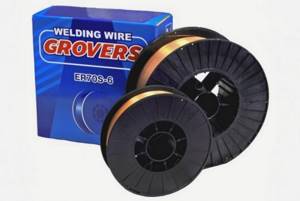
MIG/MAG welding involves the use of special wire
Often this method is also called semi-automatic, since the welder must manually move the torch along the seam. The wire is both a filler material and a conductive electrode.
Important! It is better to regulate the gas supply using reducers with flow meters.
The MIG/MAG method can be used to weld low and high alloy steels. The quality of an electric welded joint depends on the arc voltage, the feed rate of the consumable electrode, the gas feed rate and welding.
Manual arc welding
This is one of the most common technologies in the construction and repair of gas pipelines. This method can be used to weld gas pipes in different spatial positions. This is the simplest, cheapest and most accessible welding method.
Manual arc welding allows you to obtain a high-quality connection of pipe parts, since the connection involves intercrystalline bonds. Thus, the molten metal from the electrode rod and the edges of the pipes being welded forms a single weld pool and, after crystallization, forms a weld seam.
Professional connection of gas supply pipes using electric arc welding is carried out according to the following algorithm:
- Dirt, rust, oil and other contaminants are removed from the ends of the connected pipe blanks. For best results, they need to be stripped down to bare metal, especially if they have rust.
- Using special devices or a grinder with a grinding wheel, the edges are cut. The cutting angle, optimally, should be about 60° in total, that is, 30° for each edge.
- The pipes to be welded are brought together and must be coaxially centered relative to each other.
- The welding process begins with making tacks 3-4 cm long. Their number depends on the diameter of the pipe. However, you need to grab it in at least 3 places. In addition, the angle between them should be about 1200.
- After completing the tacks, it is imperative to clean the start and stop of each tack, and also check the alignment of the connected pipe parts.
- If the alignment is maintained, you can proceed directly to the final welding of the joint. It should be remembered that each welding stop requires cleaning to remove possible defects in the crater.
When connecting pipes with a wall thickness of up to 4 mm, it is recommended to carry out the welding process in one pass. If the wall thickness is more than 4 mm, then it is necessary to perform at least two passes with the obligatory cleaning of the seam from the slag crust after each pass.
Advantages and disadvantages of welding methods
Advantages of argon welding:
- high quality weld seam, reliable pipe connection;
- long service life;
- Possibility of welding stainless steel and titanium.
Disadvantages include special training and the lack of ability of some devices to operate in DC and AC/DC modes.
The advantages of MIG/MAG welding are high productivity, low smoke, ease of automation of the welding process and absence of slag. This method has limitations for outdoor use and the inconvenience of having a gas cylinder.
Semi-automatic welding of gas pipes can provide high quality connections on metals of different thicknesses, the ability to weld in many spatial positions, and low cost of work when using active shielding gases.
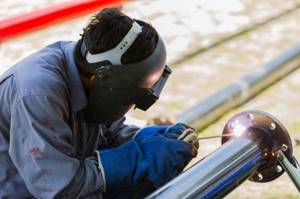
Each welding method has its own disadvantages and advantages
Butt welding of polyethylene gas pipes is quite common and provides low cost, high speed and ease of installation, as well as the ability to connect pipes with diameters of 50-1200 mm.
Useful tips and possible mistakes
To properly weld heating pipes, you should not neglect the recommendations of specialists:
- It is more convenient to weld hard-to-reach places with a bent electrode, using a mirror for control;
- when changing electrodes, the suture continues with a covering of 1.5 cm of what has already been applied;
- the quality of the welded joint will improve if the upper seam is made in the opposite direction from the lower one, finishing it in a different place;
- Direct polarity when welding with direct current provides better heating of the metal than reverse polarity.
Gas welding of steel pipes
Gas welding is based on heating the edges of pipes with an oxygen gas flame and filling the resulting gap with molten metal. Gas welding produces a connection with worse mechanical properties than electric welding, but it allows you to join small-diameter pipes with a wall thickness of up to 3.5 mm. To carry out the work you will need a gas burner and a cutter.
The welding process involves two gases – oxygen and acetylene. Oxygen supports the combustion of acetylene. It is located in special cylinders under high pressure, which is reduced during welding by using a reducer. The combustion temperature of acetylene can be 3 thousand degrees. Another flammable gas can be used instead.
Important! When burning gas, the flame temperature should be 2 times higher than the melting point of the metal being welded.
Welding wire is selected based on the identity of its chemical and physical characteristics with the same parameters of the parts being welded. The use of fluxes helps prevent metal oxidation. Gas welding allows you to obtain a strong connection between thin-walled pipes without burning through the metal.
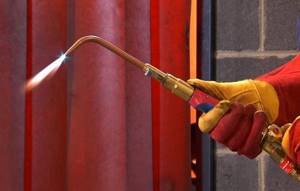
Oxy-acetylene welding is suitable for joining thin-walled pipes
Welding methods
The installation technology depends on the pipe diameter and wall thickness:
- Gas welding with acetylene or propane is used for pipes with a diameter of up to 150 mm and a wall of up to 6 mm. Joints up to 3 mm thick are welded without cutting; on the rest, the edges are pre-cut at an acute angle to form a strong joint.
- Argon arc, MIG/MAG welding is used for steel gas pipelines.
- Electric welding is carried out in small volumes, the number of penetrations depends on the thickness of the rolled product. For work, automatic, semi-automatic or manual welding equipment is used.
- A semi-automatic machine usually makes the finishing layer, using fluxes or a protective atmosphere.
- For intra-house wiring, electric welding is used in exceptional cases; gas equipment is usually used.
Each method has pros and cons. Much depends on the material being welded and access to the pipe in the areas being installed.
Butt welding of polyethylene gas pipes
Welding of gas pipes made of polyethylene can be performed using mechanically or hydraulically driven devices, as well as program-controlled devices. Special tables available in the instructions for the devices regulate, depending on the wall thickness and diameter of the pipe, the values of welding parameters - temperature, heating time, etc.
The stages of butt welding of gas polyethylene pipes are as follows:
- The parts of the pipes to be welded are installed in the welding machine.
- A heated plate is placed between the parts to be joined.
- The ends of the pipes are pressed against the plate with some force.
- After some time, the polyethylene melts.
- After the pressure on the pipes is reduced, the ends heat up.
- The hot plate is removed.
- The parts are immediately connected under some pressure.
After complete cooling, the pipeline is ready for use. The seam is very durable and high quality. It is able to withstand pressure up to 4.5 MPa.
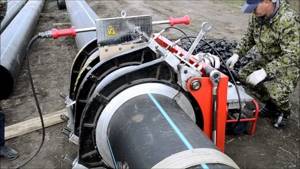
Special welding machines are used for installation of polymer gas pipes
What is needed for gas welding/cutting
Gas welding equipment is simple and convenient to carry and transport. For any type of fuel, gas welding devices have an oxygen prefix. Because without it the process is practically impossible.
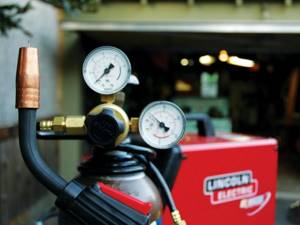
Main equipment for gas welding: cylinder or generator (gas holder), cutter. In the generator, calcium carbide produces acetylene (its formula is C2H2) mixed with water. They are mostly used by professional gas welders in their work, since this method is explosive. Therefore, in everyday life, at car service stations, in various workshops, and on sea vessels, only bottled acetylene is used.
Gas and oxygen cylinders. Oxygen does not burn, but it enhances combustion. When combined with various mineral or synthetic oils, including food grade ones, an explosion may occur.
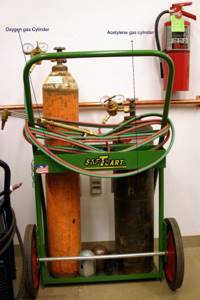
Therefore, to service blue cylinders, almost medical sterility is required: clean gloves, well-washed or grease-free keys, gearboxes.
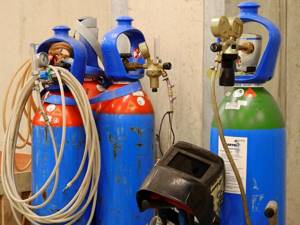
Each type of gas has its own valve and reducer so that there is no additional reaction with the metal. The valves for acetylene are steel, oxygen and propane/butane are brass. Reducers designed for a certain pressure are connected to them: acetylene - 2.5 MPa (5320 liters of gas in a cylinder), oxygen - 15 MPa (6000).

Porous material (charcoal) is poured into white cylinders and acetone is poured in, and only after that acetylene is pumped in. Another chemical reaction occurs inside and additional acetylene is produced.
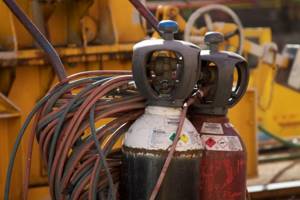
How to cook with gas welding? Mixing oxygen with gases is the same. In the cutter, the flame amplifier is combined with ethyne and the vapor comes out of the burner nozzle after ignition with a blue fire.
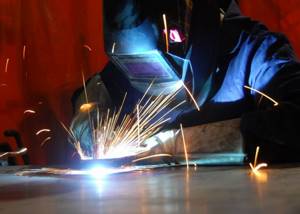
Features of welding work in an apartment
For safety reasons, before starting welding work, the gas in the apartment is turned off. Household gas is highly flammable, so if the pipes are not shut off in time, it can lead to a fire. Welding of small diameter pipes can be carried out by one person.
Note! To connect pipes with different diameters, special adapters are used, which will reduce the likelihood of gas leakage.
Gas pipes in an apartment are often welded end-to-end. In this case, the arc must be conducted so that the edges of the product have time to melt a little, and the required amount of filler material is deposited on them. This will ensure the quality and aesthetics of all seams.
It is often necessary to digest a gas pipe in an apartment when moving it. After shutting off the gas, the process proceeds in the following sequence:
- The gas pipeline is purged to remove remaining gases.
- The unnecessary pipe is cut off, and the resulting hole is welded.
- A hole is drilled in the required location and the metal pipe outlet is welded to the gas pipeline.
- A tap is mounted to the outlet and a connection is made to the slab.
The presence of a leak is determined using special tests. If it is detected, re-installation is carried out. Upon completion of the work, gas is turned on and the functioning of the pipes is checked.

Before you begin installing the gas pipeline in the apartment, you need to turn off the gas supply valve
Polymer pipelines
The polymer material used for the production of gas pipes is able to withstand high temperatures and pressures.
HDPE (low-density polyethylene) pipes are most often used for laying underground gas pipelines. To connect individual sections of polyethylene gas pipelines, the butt method is used.
It consists of heating the end of each section of the gas pipe and then connecting them under a certain pressure. Thus, an interatomic connection of the gas pipe material is made.
A fairly new variety, very simple and in demand. High qualifications are not required to perform the work. The welded joint can withstand pressure of no more than 40 atm.
When assembling large-diameter pipelines, special equipment is used; for assembling small-section pipelines, hand tools are used.
Regardless of the thickness of the gas pipes, work is carried out in one way. Strong heating takes place. Then squeezing and getting a joint. Small diameter pipes are connected using electric couplings. The heating temperature of the edges is no more than 2700.
For polypropylene pipes, the socket welding method is used. Polypropylene pipes are used mainly for laying internal water supply and sewerage systems, some brands are used for heating systems.
Safety precautions when welding gas pipes
If you need to move or digest gas pipes in your apartment, you should contact the gas service. In an apartment building, it is prohibited to carry out such work yourself; if necessary, they are performed by specialists from specialized organizations.
During the welding process, particles appear in the air from the oxidation of metal vapors. There is a danger of explosion due to improper handling of the acetylene generator and burner due to backfire. In addition, oxygen reducer valves may ignite or if the cylinder is opened suddenly. The most dangerous is the explosion of an oxygen cylinder, which is under high pressure.
Gas welding is harmful to vision due to the action of visible and infrared rays. It is prohibited to carry out welding work close to flammable and flammable materials. The room where gas pipes are welded must be well ventilated.
Before supplying gas to the pipes after welding, all connections must be checked for leaks. Only a specialist can weld gas pipes efficiently and safely.
Welding gas pipes with your own hands: how and what is done, methods, equipment and materials
The topic of pipe welding is very broad and complex. Mainly due to the fact that stores offer a large number of blanks. There are many types of pipes in diameter and material.
They can be wide, narrow, plastic, steel or alloys. Pipe material is only one of the parameters important for choosing a welding method and technique.
For gas supply, for example, pipes made of different steels are used. And in order to create a gas pipeline structure, you need to have experience and an understanding of the basic rules of the welding process.
Beginners will not be able to weld such pipes on their own; this is a task for experienced welders. If you have long mastered various methods of creating structures and several types of welding, you will be able to install a gas system in your home.
What techniques are needed in this case, and how to weld a gas pipeline yourself? We'll tell you in this article.
general information
Which technology to choose? Argon arc welding, inverter MIG/MAG and gas welding are suitable for gas pipes.
There are also production technologies that include large-scale automatic equipment and have high productivity on an industrial scale.
We are talking about home welding here, and we don’t need the features of conveyor production. The technologies that we listed before will just help you weld gas pipes in a residential area.
There is no ideal welding technique. Each of them can be viewed from both the “light” and “dark” sides. We will not recommend any of them by calling them “the best.”
It all depends on the thickness of the walls of your pipes, their diameter, and the type of steel from which the pipes are made. In some cases, work sites are difficult to reach, and this must also be taken into account when choosing a technology.
In any case, before soldering, free the edges of the pipes from paint, dust and rust. Afterwards you need to cut them if they are thicker than six millimeters.
The type of cutting is selected depending on where the pipe will be located in the structure.
The creation of a gas pipeline must be approached responsibly. If the seams oxidize, crack, or simply do not have sufficient sealing, a leak will occur on the first day of using the system.
This increases the risk of poisoning, fire or even explosion in the apartment. To avoid these consequences, you must first of all not skimp on consumables. But it is also important to study the welding method you need and its nuances.
MIG and MAG welding
The MIG/MAG method combines filler wire and a protective gas atmosphere.
The welder can feed the filler material into the weld pool manually, use a semi-automatic machine in which he controls only the feed rate, or use automatic equipment that controls the wire completely mechanized.
The first technology is the most economical option. Manual feeding of filler wire does not require expensive equipment with complex microcircuits and automation.
But this method is more difficult: manual application of the additive can be learned after months of practice.
Automatic equipment for MIG/MAG costs from five hundred dollars. This price did not come out of thin air. The machines handle most of the processes themselves.
The welder only lights the arc and leads it, creating a connection. Wire feeding and speed are fully automatic.
A semi-automatic welding machine is more versatile. It helps the welder deal with the additive, which makes the job easier. It costs less than an automatic one, but the quality of finished seams is not inferior to it.
In addition, the semi-automatic machine can be used for different steels: low-carbon, high-carbon, stainless steel and others.
The connection under such conditions is formed due to two factors: melting of the edges of the pipes and solder of the filler material. If you practice and learn how to use a semi-auto well, you will have a sealed gas design.
To do this, you also need to correctly install the supply from the gas cylinder. A gearbox will simplify the task. A little shielding gas is consumed, and no more should be consumed.
For example, if you cook a thin pipe in a carbon dioxide environment, no more than fifteen liters will come out of the cylinder.
Gas welding
When joining metals in this case, a special wire, oxygen and ethylene, a colorless flammable gas, are used. It burns and melts metal workpieces, and the combustion of this gas is supported by an oxygen environment.
With this technology, the seam will be loose and of worse quality than that of semi-automatic machines or arc welding with argon.
There will also be twice as many gas cylinders, whose supply needs to be controlled. This method is complex, so when starting work, you must be 100% confident in yourself.
The material of the wire must be the same as the metal of the pipes being connected. Reducers must be placed on both cylinders - with acetylene and oxygen.
Welding gas pipes in an apartment
Knowing the features will help you both if you create a gas pipeline yourself, and if you want to monitor the work of hired craftsmen.
First, the gas supply in the apartment is shut off. This is the first rule that must be followed to avoid fire. If the employees have not done this, convincing you that “everything will be fine,” you should already be wary.
Small pipes can be handled by one person. If the pipes are of different cross-sections, you will need to buy several adapters to weld them. They will help prevent gas leaks. Pay attention to how tightly they are attached to the pipes.
To remove residual household gas from the pipes, they need to be purged. Then the steps are chosen based on what exactly you need to do.
If the pipes need to be routed to another location, a hole is drilled in them through which an outlet is welded to the system. Then a valve lever is connected to the outlet to regulate the gas supply.
How to check if there is a domestic gas leak in a gas pipeline? Most often this is done using a solution with liquid soap or any other foaming product. Apply it to the joint and wait a little.
If the solution produces bubbles in some places, gas will definitely flow in these places. In this case, the pipes must be welded again. If there are no leaks, you can reintroduce gas through the pipeline.
Conclusion
The creation of pipeline structures is responsible protection. This is especially true for explosive household gas systems.
In workshops and large enterprises, diagrams are often created that show what pipe connections should be in each specific location.
For yourself and for renovation work in the apartment, you can sketch out an approximate drawing of pipe joints. It is not necessary to indicate everything exactly, the main thing is that you understand the principle. This will make things easier for you.
